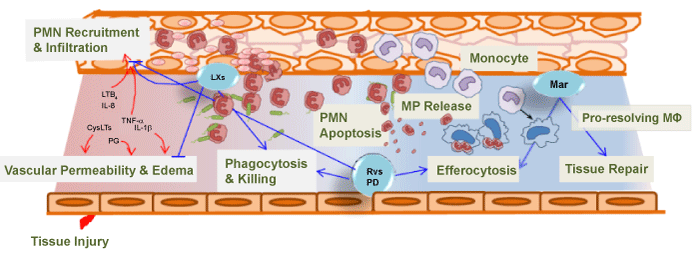
 |
| Figure 1: Multistep processes in acute inflammation and resolution. Microbial infections or tissue damage precipitate an acute inflammatory response in peripheral vascularized tissues, characterized by edema, exudate formation, and leukocyte infiltration. Polymorphonuclear leukocytes (PMN) are among the first leukocytes that infiltrate and fight the pathogenic noxa through engulfment and phagocytosis. Their apoptosis followed by removal initiate tissue resolution. Monocytes that enter the inflamed site as second wave and differentiate into pro-resolving macrophages (MФs) are master cells in resolution. Activated leukocytes release MPs that can promote resolution. Ancient physicians defined resolving exudates pus bonum et laudabile (“good and laudable pus”) as soon as they recognized that it anticipated the resolution of infections and healing of wounds. Today, we appreciate that exudates, in addition to deliver leukocytes in inflamed tissues, also carries bio-precursors for lipoxins, E-series Resolvins, D-series Resolvins, Protectins (neuroprotectin D1), and Maresins, collectively known as specialized pro-resolving lipid mediators (SPM). SPM work to keep the inflammatory response within physiological boundaries and accelerate the return to homeostasis, providing novel opportunities of therapeutics and treatment of human diseases. For more details on the historical steps that changed our understanding and concepts on the process of resolution of acute inflammation. |